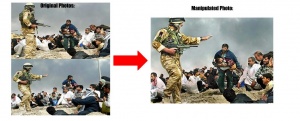Fake News
Fake News is a fairly new term given to certain news articles, web posts, pictures, etc.. that intentionally try to spread false information. This false information is usually aimed at damaging a large entity or famous person, however the subject can be nearly anything or anyone. Media platforms historically have always had ethical dilemmas (i.e. Yellow Journalism, sloppy journalism, etc.) but the emergence of social media and the subsequent rise of modern fake news has ushered in a new era of ethical concerns. There are many reasons to create fake news articles but the main ones are to discredit/damage someone or something, to make money off the spreading of the article itself, or simply to get a good laugh out of people's reactions.
Contents
Background
History
Fake news became a household term in late 2016 - early 2017 when the U.S. presidential candidates, Hillary Clinton and Donald Trump, began to use it in speeches and social media posts. Who coined the term first is difficult to trace but the origin of the first big fake news articles stemmed from the small town of Veles, Macedonia.[1] The young adults of Veles figured out a get-rich-quick scheme by pumping out fake news articles to Facebook in order to gain the advertising money available on the site. Thus a group of teenagers from Macedonia introduced fake news to the general U.S. public, writing many articles mainly centered around the 2016 U.S. presidential election. Being the hottest topic of mid-late 2016, any kind of fake news article about Hillary Clinton or Donald Trump was sure to sell online. Stories such as "Pope Francis endorses Donald Trump" and "FBI Agent in Clinton email case found dead" went viral instantly. The Macedonians demonstrated to the world that intentionally deceitful internet articles centered around popular figure heads sell.
Types
Fake news comes in many different forms, there are six easily identifiable types: Click bait, Propaganda, Satire, Sloppy Journalism, Misleading Headlines, and Biased News.[2] Click bait is defined as stories that intentionally use a ridiculous headline to gain site views at the price of truth and actual content. Propaganda is intentionally writing a story in a biased slant in order to achieve some agenda. Satirical fake news is created with the intention of entertainment and comedy. Sloppy Journalism occurs when the writer of an article/post uses unreliable sources containing fake news, it is not necessarily the writer's fault for spreading fake news but it is they are at fault for not double-checking their sources. Misleading headlines are similar to Click bait but with more substance within the article. Finally, Biased News stories are created to appeal to people's pre-existing beliefs. Unlike propaganda, these articles are written to gain attention not necessarily to shift beliefs.
Ethical problems with Fake News
Mental and Physical Damage
The writers/creators of fake news are usually intentionally deceiving their audiences in one manner or another. It can be for monetary or political gain or simply out of boredom. Either way, the writers are misleading their audiences and causing problems. Christopher Blair is a prime example of someone who was bored one day and decided to start writing fake news articles to get a kick out of people's reactions. Blair created his own Facebook page, America's Last Line of Defense -a political right-wing satirical page, where he publishes several articles a day, each making some ludicrous claim either promoting or demonizing a political figure.[3] Blair's page does contain a warning that the posts are not real but for many readers, this warning goes unnoticed. A vast majority of Blair's readers are adults and elderly people, many of whom struggle to distinguish real and fake news online. What Blair is doing is very common online, there are a vast amount of writers who test their skills with satire online in order to get reactions or gain advertisement money. Serious damage can come from these sorts of sites, most of the readers are not aware that the articles that they're internalizing and sharing are actually fake. Coming to this realization can be difficult for the reader, as Harry Frankfurt notes: "When someone is lied to by a person they trust, it causes them to look inwards on their own decision making to see who they can trust."[4]. In other words, many people trust and believe that articles such as Blair's tell the truth, and when they're proven wrong, it can be difficult for them to believe any kind of news in the future. Fake news can also lead to violent interactions in the real world as observed in the Pizza Gate scandal in 2016, where a man barged into a pizza shop in Washington D.C. with a rifle in order to free the child sex slaves he believed to be hidden in the basement.[5] The man fired several shots in the ceiling, no one was hurt but this incident only occurred because the man truly believed a fake news article. Incidents of mental and even physical damage have chances of occurring as long as the readers of fake news truly believe in what they're reading. A grain of salt is needed with online articles in order to avoid mental and even psychical damage from occurring.
Proving a point?
Fake news articles seem to gravitate around celebrities, after all stories about popular individuals will gain more attention than one about George Johnson from Iowa. Justin Bieber has been a headline-worthy celebrity for quite some time, so a YouTube channel known as Yes Theory decided to do a "challenge", to see if they could get a fake news article -about Justin- to go viral. They decided they would hire a Justin Bieber look-a-like, dress him up to look even more the part, and have him do several mildly infuriating things around Los Angeles.[6] One of the infuriating actions they had the pretend Bieber do was to sit on a park bench and eat a Chipotle burrito from the middle instead of the ends as most people do. The group sent the photos to news editors and posted them online and within 48 hours, the picture was trending on Twitter, Reddit, and was featured on several news channels. The Yes Theory crew had achieved their goal of seeing if they could trick the world. The picture was taken with the intent to deceive but was done in a different sort of manner, not to achieve personal fame or money but to simply see if they could achieve a viral post. The extremity of the picture differs drastically from articles such as Blair's, a simple photo of a celebrity doing something weird as opposed to an article about a leading politician running a child-sex ring. However, reinforcing Frankfurt's point, lies can hurt people and it is possible that people will not be as willing to believe these kinds of posts when they emerge next time. As for the news sites and shows that showcased the photo, their credibility may have taken a knock due to their sloppy journalism.Personal Gain
Sometime fake news can be implemented in order to gain something personally, money, fame, power, etc.. The appeal of personal achievement can drives credible news personnel to stretch the truth and misuse their position of power. In February 2003, Brian Walski -former photographer of the LA Times- submitted a photo from the ongoing Iraq War that was later found to be an alteration of two images brought together[7]. The image -pictured left- was briefly crowned as one of the most breathtaking of the war and would have expanded Walski's reputation as an accredited photographer, instead the opposite occurred. Professional journalists and photographers are kept to a high ethical code and when this code is broken, it can be difficult to undo the damage and re-enter the spotlight. Brian Williams, former news anchor for NBC Nightly News, was another famous journalist that spread fake news about the Iraq War in 2003. Back in this time, Williams was an on-the-scenes reporter covering the early stages of the war. One day he was riding in a US military helicopter when Williams said the helicopter was shot at and was experiencing difficulty keeping altitude due to the shots from the ground. Williams circulates his story and it was believed to be fact until February, 2015 when it was revealed Williams had lied about the bullets, taking a typical helicopter malfunction for gunshots.[8] Williams was subsequently fired from NBC and has been unable to re-enter the realm of news anchoring since the revelation of his fake encounter. As noted with the teenagers in Veles, Macedonia, monetary incentives drive fake news articles more effectively than anything else. Brian Walski and Brian Williams fabricated fake news surrounding the Iraq War in order to sell their media content and gain popularity within the world of journalism. In the end, the strong ethical code discerning fake news ended the careers of Brian Walski, Brian Williams, and numerous other journalists.
Future Concerns
Today fake news is principally comprised of news articles and images that a decent percentage of people can identify is fake since there usually lacks any true evidence. However, the era of fake news could take an entire new form in the near future as rapid technological advancements continue. It is debated that software will soon be available that enables users to create fake videos of people, potentially even using their real voice. Should this software actually be available, this would allow creators to make fake news videos of celebrities doing odd or damaging things in order to sell the video to news sources. Big names would be greatly impacted as the fake videos would target a plethora of celebrities and politicians. Thomas Kent argues this could even sway entire elections down the line should enough people buy into the difficult-to-discredit videos.[9] The emergence of realistic fake videos would add a new element to the fake news spectrum and likely lead to more and more fake news being credited as real. Careers could be ruined and credible journalism could take a major blow as sites posting the videos cannot tell it's authenticity, the trust of news as a whole could take a turn for the worse. According to Kent, action needs to be taken sooner rather than later, in whatever form possible. He suggests passing laws to discourage the creation of these videos before they eventually come, if they do.Cite error: Closing </ref> missing for <ref> tag</ref>
References
- ↑ Wendling, Mike. “The (Almost) Complete History of 'Fake News'.” BBC News, BBC, 22 Jan. 2018, www.bbc.com/news/blogs-trending-42724320.
- ↑ “Explained: What Is Fake News? | Social Media and Filter Bubbles.” Webwise.ie, 2 July 2018, www.webwise.ie/teachers/what-is-fake-news/.
- ↑ Saslow, Eli. “'Nothing on This Page Is Real': How Lies Become Truth in Online America.” The Washington Post, WP Company, 17 Nov. 2018, www.washingtonpost.com/national/nothing-on-this-page-is-real-how-lies-become-truth-in-online-america/2018/11/17/edd44cc8-e85a-11e8-bbdb-72fdbf9d4fed_story.html.
- ↑ Frankfurt, Harry. “On Truth, Lies, and Bullshit.” The Philosophy of Deception, by Clancy W. Martin, Oxford University Press, 2009, pp. 43
- ↑ Tandoc, Edson C, et al. “Defining ‘Fake News.’” Digital Journalism, 30 Aug. 2017.
- ↑ Theory, Yes, director. We Fooled the Internet w/ Fake Justin Bieber Burrito Photo. YouTube, YouTube, 28 Oct. 2018, www.youtube.com/watch?v=Vs6In7UtyXY.
- ↑ Carlson, Matt. “THE REALITY OF A FAKE IMAGE News Norms, Photojournalistic Craft, and Brian Walski's Fabricated Photograph.” Journalism Practice, vol. 3, no. 2, 2009, pp. 125–139., doi:10.1080/17512780802681140.
- ↑ McCarthy, Tom. “Brian Williams Told Military Newspaper He 'Assumed' His Helicopter Had Been Hit.” The Guardian, Guardian News and Media, 9 Feb. 2015, www.theguardian.com/media/2015/feb/09/brian-williams-assumed-helicopter-hit-stars-and-stripes.
- ↑ Kent, Thomas. “Fake News Is about to Get so Much More Dangerous.” The Washington Post, WP Company, 6 Sept. 2018, www.washingtonpost.com/opinions/fake-news-is-about-to-get-so-much-more-dangerous/2018/09/06/3d7e4194-a1a6-11e8-83d2-70203b8d7b44_story.html?noredirect=on&utm_term=.bfe7ccd2ed17.


